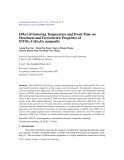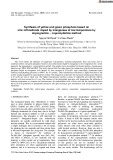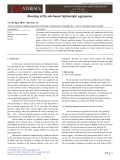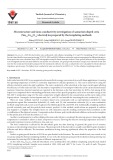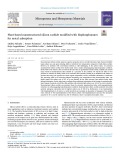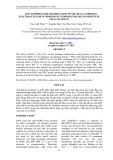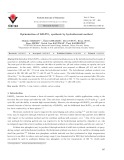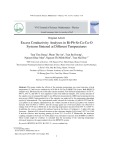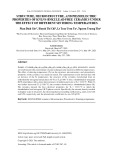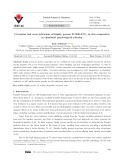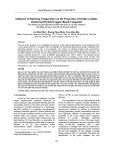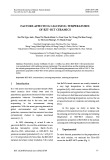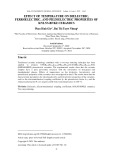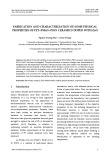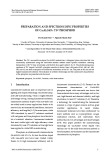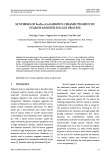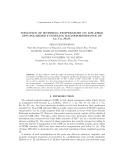
Sintering temperature
-
The material’s structure was analyzed through X-ray diffraction and scanning electron microscopy. The fabricated materials consist of NiTiO3 with a rhombohedral phase structure and CoFe2O4 with a cubic structure. The effect of sintering temperature and dwell time on the phase, microstructure, and ferroelectric properties of the ceramics was examined.
 12p
12p  dianmotminh02
dianmotminh02
 03-05-2024
03-05-2024
 1
1
 1
1
 Download
Download
-
The highest luminescence product consists of spheroidal and relatively uniform particles with sizes around 0.6-1.0 µm. The variation of the precipitated precursor with temperature, the influence of sintering temperature on structure and luminescence, the mineralization role of boric acid and the chemical reactions that occur with generation of precipitated precursors and upon heating to give luminescent solid solution products are mentioned.
 10p
10p  dianmotminh02
dianmotminh02
 03-05-2024
03-05-2024
 2
2
 1
1
 Download
Download
-
The present work characterized two types of fly ash, one from pulverized coal combustion and the other from fluidized bed combustion. The effects of fly ash origins, raw mix proportions, and sintering temperatures on the bloating of lightweight aggregates were studied. The raw mixtures were calculated based on Riley's SiO2 – Al2O3 – fluxing composition diagram.
 5p
5p  visharma
visharma
 20-10-2023
20-10-2023
 5
5
 4
4
 Download
Download
-
Sm0.2Ce0.8O1.9 (SDC20) electrolytes were synthesized with cellulose templating (CT) and PVA templating (PVAT) methods. Powder characteristics were examined using TG/DTA, XRD, and SEM. Pellets are sintered at various temperatures for different durations. Mean grain sizes were calculated from SEM micrographs using the linear intercept method. Grain growth behavior of the electrolytes was investigated and the dominant diffusion mechanism was examined.
 13p
13p  lyhuyenthu
lyhuyenthu
 31-01-2023
31-01-2023
 5
5
 3
3
 Download
Download
-
Nanostructured silicon carbide possesses superior properties such as excellent hardness, high chemical stability, large surface area and good sintering ability at relatively low temperatures compared to bulk silicon carbide.
 11p
11p  vironald
vironald
 15-12-2022
15-12-2022
 3
3
 2
2
 Download
Download
-
The composite electrolyte also showed one and half order magnitude higher ion conductivity than pure SDC electrolyte at measuring temperature ranges. Bismuth samarium oxide formed by reaction between Bi2O3 and SDC during sintering seems to enhance to electrical performance because it is known that it has superior ionic conductivity to SDC.
 7p
7p  vikissinger
vikissinger
 03-03-2022
03-03-2022
 7
7
 1
1
 Download
Download
-
Optimization of the LiFePO4 cathode active material synthesis process in the hydrothermal method consists of many factors, including pH, carbon coating, particle size optimization, sintering and hydrothermal synthesis temperature. The main goal of this study is to determine the effect of particle size, pH and carbon coating on capacity and cycle performance. In this study, LiFePO4 cathode active materials were prepared at different pH (6.5 and 8.5) and temperature (160 and 180◦C) levels using the hydrothermal method.
 12p
12p  langthannam
langthannam
 29-12-2021
29-12-2021
 16
16
 0
0
 Download
Download
-
The use of multiwalled carbon nanotubes (CNTs) in sol-gel synthesized titanium dioxide (TiO2) photocatalysts as templates was systematically studied. CNTs have high oxidative thermal stability and the controlled removal of CNTs can be achieved at lower temperatures under air flow by the use of Na, Fe, and Co as a catalyst. These catalysts helped to reduce the oxidation temperature of CNTs; thus anatase phase was achieved without significant sintering.
 15p
15p  langthannam
langthannam
 29-12-2021
29-12-2021
 8
8
 0
0
 Download
Download
-
This paper studies the effects of the sintering temperature on crystal structure, critical temperature (Tc) and excess conductivity of Bi-Pb-Sr-Ca-Cu-O (BPSCCO) system. Bulk BPSCCO samples were fabricated by the solid-state reaction method. Four different temperatures of 835 °C, 840 °C, 845 °C, and 850 °C were applied to sinter four different samples.
 10p
10p  meyerowitz
meyerowitz
 25-12-2021
25-12-2021
 5
5
 0
0
 Download
Download
-
The fracture toughness of the composites showed a reverse trend. By adjusting the graphite content to 6 wt%, excellent control of microstructure could be achieved for the prepared composites with a higher amount of ZrC and lower content of other unfavorable phases.
 7p
7p  meyerowitz
meyerowitz
 25-12-2021
25-12-2021
 13
13
 0
0
 Download
Download
-
The experimental results showed that with an increase of the TS temperature, the structure of the ceramics transformed from an orthorhombic-tetragonal mixed phase (O-T) at TS 1100 °C into a rhombohedral-tetragonal (R-T) mixed phase with a dense microstructure of uniform grain size at TS = 1110 °C. When TS was further increased.
 10p
10p  spiritedaway36
spiritedaway36
 28-11-2021
28-11-2021
 15
15
 2
2
 Download
Download
-
Highly porous Ti matrix composites can be a solution for some of the major clinical concerns for the load bearing implants such as low tribocorrosion resistance, stress shielding, and lack of biological anchorage. In order to respond to these needs, highly porous Ti-TiB-TiNx in-situ composites were synthesized by pressureless sintering using BN as reactant and urea as space holder. Corrosion behaviour was investigated at body temperature, in phosphate buffer saline solution (PBS), by measuring open circuit potential (OCP) and cyclic polarization.
 12p
12p  tudichquannguyet
tudichquannguyet
 29-11-2021
29-11-2021
 12
12
 1
1
 Download
Download
-
The aim of this research is to investigate the influence of the sintering temperature on the properties of the in-situ carbide (Nb,Ti)C in a copper matrix synthesized via mechanical alloying and powder metallurgy from elemental powders of Cu, Nb, Ti and graphite. The mixture of starting powders with compositions corresponding to Cu-15vol.% (Nb, Ti)C was mechanical alloyed using a planetary ball mill for 20 hours.
 6p
6p  quenchua12
quenchua12
 10-05-2021
10-05-2021
 11
11
 1
1
 Download
Download
-
In this paper, we study, in detail, the influence of the nanostructure of raw materials and the sintering aid CuO on the calcining and sintering temperature of BZT–BCT ceramics. The piezoelectric properties of BZT–BCT at the optimal calcining and sintering temperature are addressed.
 6p
6p  nguaconbaynhay10
nguaconbaynhay10
 20-02-2021
20-02-2021
 17
17
 1
1
 Download
Download
-
Traditional ceramic technology combined with a two-step sintering technique has been applied to prepare 0.96(K0.48Na0.48Li0.04)(Nb0.95Sb0.05)O3-0.04Bi0.5(Na0.82K0.18)0.5ZrO3 (KNLNS-BNKZ) piezoelectric ceramics. The experimental results show that the ceramic samples have a pure perovskite structure with the coexistence of tetragonal and rhombohedral phases.
 10p
10p  nguaconbaynhay10
nguaconbaynhay10
 19-02-2021
19-02-2021
 17
17
 2
2
 Download
Download
-
he effect of the ZnO addition in pure perovskite PZT−PMnN−PSbN ceramics sintered from 950 to 1200oC has been investigated. The phase structure of ceramics changes from rhombohedral to tetragonal and the temperature decreases with the increase of the ZnO content. The limitation of Zn2+ concentration for the solubility in PZT–PMnN–PSbN systems is about 0.25% wt., at which the ceramic shows some good physical properties such as the density of 8.20 g/cm3 , some dielectric constants including εr = 1,555 and εmax = 32,900.
 9p
9p  nguaconbaynhay9
nguaconbaynhay9
 03-12-2020
03-12-2020
 7
7
 0
0
 Download
Download
-
The Tb3+ rare-earth-ion-doped Ca2Al2SiO7 material has a tetragonal phase structure that was successfully synthesized using the solid-state reaction method under optimal conditions: sintering temperature: 1280 °C; time: 60 minutes; and the B2O3 flux agent content: 4% wt. The photoluminescence spectrum of Tb3+ doped Ca2Al2SiO7 phosphor consists of narrow lines with peaks at 545, 440, 462, 494, 590, and 622 nm that correspond to 4f electronic transitions of the Tb3+ ion. The peak at 545 nm has the highest luminescent intensity.
 4p
4p  nguaconbaynhay9
nguaconbaynhay9
 03-12-2020
03-12-2020
 7
7
 1
1
 Download
Download
-
In the present paper, the ceramic pigments FexZn1-xCr2O4 (x = 0 1) were synthesized with the starch-assisted sol-gel method. The resulting pigments were characterized using X-ray diffraction (XRD), scanning electron microscopy (SEM), and CIE L*a*b* color measurement. The results show that FexZn1-xCr2O4 pigments form at sintering temperature of 1100 OC for 60 minutes. The ACr2O4 spinel (A: Zn, Fe) and FeCrO3 perovskite phase with excellent crystallinity appears. The brown color intensity increases gradually with the increase of the number of substituted Fe2+ cations.
 7p
7p  nguaconbaynhay9
nguaconbaynhay9
 03-12-2020
03-12-2020
 4
4
 1
1
 Download
Download
-
In this study we report the effect of sintering temperature on the low field magnetoresistance (LFMR) of La0,7Ca0,3MnO3 manganite synthesized through sol-gel technique. The La0,7Ca0,3MnO3 has been sintered at 600˚C, 700˚C, 800˚C, 900˚C and 1200˚C. The crystallite as well as particle size also show strong dependence on the sintering temperature. While the ferromagnetic – paramagnetic (FM-PM) transition temperature remains almost constant, the metal – insulation transition temperature drop gradual and the low field magnetoresistance (LFMR) increase with a decrease in grain size.
 11p
11p  nguyenxuankha_bevandan
nguyenxuankha_bevandan
 14-08-2020
14-08-2020
 15
15
 3
3
 Download
Download
-
The rapid increase in emissions of major greenhouse gases such as CO2 and CH4 in the last decade has seriously affected the climate change and the living environment in the world in general and in Vietnam in particular. In addition, the demand for effective use of CO2 - rich natural gas has promoted studies to find new, highly active and stable catalysts for the methane reforming process. NiO has proven to be the most suitable catalyst for industrial application of the reforming process.
 13p
13p  nguathienthan2
nguathienthan2
 24-12-2019
24-12-2019
 21
21
 0
0
 Download
Download







